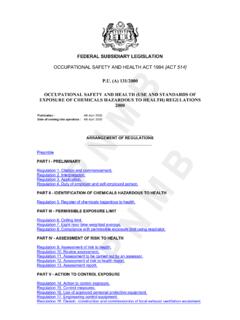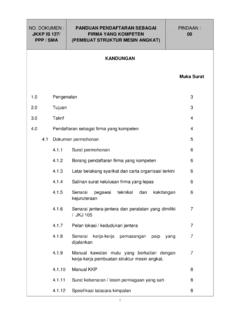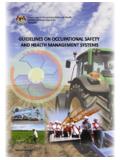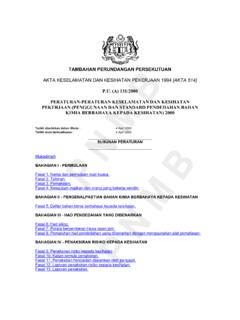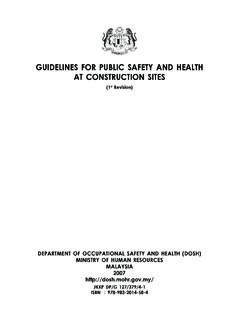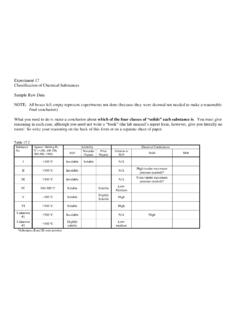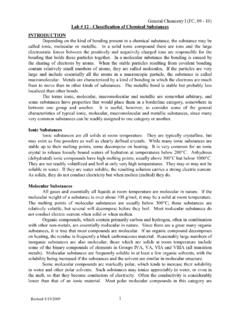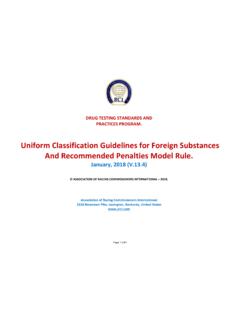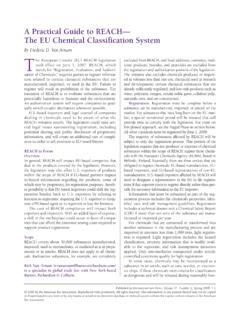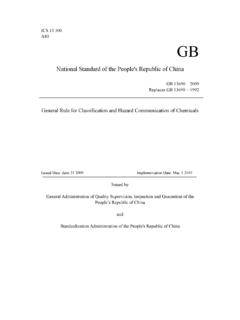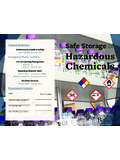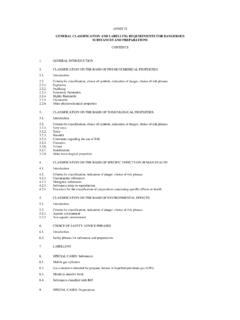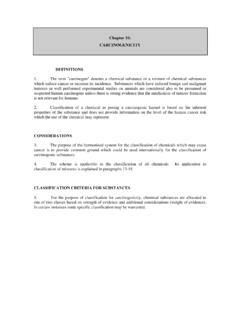Transcription of GUIDELINES FOR THE CLASSIFICATION OF HAZARDOUS …
1 GUIDELINES FOR THE CLASSIFICATION OF HAZARDOUS CHEMICALS DEPARTMENT OF OCCUPATIONAL SAFETY AND HEALTH MINISTRY OF HUMAN RESOURCES MALAYSIA 1997 JKKP: GP (I) 4/97 ISBN 983-99156-6-5 GUIDELINES for the CLASSIFICATION of HAZARDOUS Chemicals Department of Occupational Safety and Health (DOSH) MALAYSIA iii Table of Contents Preface 1 Glossary 2 1. Introduction 4 2. CLASSIFICATION Based on Physicochemical Properties 4 3. CLASSIFICATION Based on Health Effects 10 4. Listed HAZARDOUS Chemicals Based on Health Effects 22 5. Non-Listed HAZARDOUS Chemicals Based on Health Effects 23 6. Procedure for Classifying Chemicals Based on Health Effects 23 References 26 Appendices Appendix I : Formula for CLASSIFICATION of mixtures with 27 ingredient considerations below cut-off levels and having additives effects.
2 Appendix II : Recommended Risk Phrases for Classifications 30 Based on Health Effects Appendix III : Procedure for Classifying a HAZARDOUS chemical 31 Appendix IV : Health-Effects Based CLASSIFICATION of Non-Listed 32 HAZARDOUS Chemicals and Recommended Risk Phrase Appendix v : Classifying a Chemicals Mixture Using the 37 Concentration Cut-Off Level Concept Appendix VI : Choice of Risk Phrases 41 Appendix VII : List of HAZARDOUS Chemicals 47 GUIDELINES for the CLASSIFICATION of HAZARDOUS Chemicals Department of Occupational Safety and Health (DOSH) MALAYSIA 1 PREFACE These GUIDELINES may be cited as the GUIDELINES for the CLASSIFICATION of HAZARDOUS Chemicals (hereinafter referred to as the GUIDELINES .)
3 The purpose of the GUIDELINES is to elaborate on and explain the requirements of Regulation 4 of the Occupational Safety and Health ( CLASSIFICATION , Packaging and Labelling of HAZARDOUS Chemicals) Regulations 1997 [ (A) 143] (hereinafter referred to as the Regulations ) which stipulates the duty of a supplier of HAZARDOUS chemicals to classify each HAZARDOUS chemicals according to the specific nature of the risk involved in the use and handling of the chemicals at work. The GUIDELINES also recommend appropriate risk and safety phrases to be assigned to the chemical and which must be included on the label of the packaging of the HAZARDOUS chemicals and which must be included on the label of the packaging of the HAZARDOUS chemicals as required by Regulation 7 (1) (d) of the Regulations.
4 Suppliers of HAZARDOUS chemicals are advised to familiarize themselves with the GUIDELINES and follow these closely in classifying HAZARDOUS chemicals. When there is any conflict or inconsistency between the GUIDELINES and the Regulations, then the provisions of the Regulations will prevail. A supplier, however, may choose to interpret the requirements of the Regulation differently but in such a case he has to prove to the Director General of Occupational Safety and Health that his interpretation is, in effect, at least on a par with the interpretation given in the GUIDELINES . The GUIDELINES must be read in conjunction eith the Regulations, the GUIDELINES for Labelling of HAZARDOUS Chemicals, and the GUIDELINES for the Formulation of a chemical Safety Data Sheet.
5 These GUIDELINES will be reviewed from time to time. Suppliers are welcome to respond with feedback to the Department in writing with a view to making the GUIDELINES more comprehensive and user-friendly. Director General Department of Occupational Safety and Health Malaysia December 1997 GUIDELINES for the CLASSIFICATION of HAZARDOUS Chemicals Department of Occupational Safety and Health (DOSH) MALAYSIA 2 Glossary Acute health risk risk which may result in adverse effect that occurs immediately or shortly after exposure Boiling point the temperature of a liquid at which the vapour pressure ( the pressure characteristic at any given temperature chemical any chemical element, compound or mixture thereof, whether natural or synthetic, but not including any microorganism CAS Number chemical Abstracts Service Registry Number.)
6 The unique number assigned to a chemical by the chemical Abstracts Service, Columbus, Ohio, USA. Carcinogenic substances or preparations which if inhaled or ingested or penetrated into the skin, may include cancer in human or increase its incidence Chronic health risk risk which may result in an adverse effect that occurs after repeated or prolonged exposure Flash point the lowest temperature in degrees Celsius at which a liquid will produce enough vapour to ignite HAZARDOUS chemical any chemical possessing any of the properties described in Parts A or B of Schedule I of the Regulations or for which relevant information exists to indicate that chemical is HAZARDOUS LC50 a concentration of a chemical in air which is estimated to produce death in 50% of an experimental animal population on inhalation over a specified short period of time LD50 a dose of a
7 chemical applied through ingestion, injection or skin application which is estimated to produce death in 50% of an experimental animal population Mutagenic substances or preparations which if inhaled or ingested or penetrated into the skin may induce genetic changes in spermatozoa or ovum cells or increase their incidence Teratogenic substances or preparation which if inhaled or ingested or penetrated into the skin of a pregnant woman, may induce deformation in the foetus or increase its incidence GUIDELINES for the CLASSIFICATION of HAZARDOUS Chemicals Department of Occupational Safety and Health (DOSH) MALAYSIA 3 UN Number United Nation Number, a system of four digit number assigned by the United Nation Committee of Experts on the Transport of Dangerous Goods.
8 UN Number are assigned to one substances or to a group of substances with similar characteristics. They are not necessarily unique to one chemical , and may cover a group of chemicals with similar HAZARDOUS properties, for example, Organophosphorus pesticides, liquid, toxic - UN No. 3018. 1. INTRODUCTION GUIDELINES for the CLASSIFICATION of HAZARDOUS Chemicals Department of Occupational Safety and Health (DOSH) MALAYSIA 4 Regulation 4 stipulates the duty of a supplier of HAZARDOUS chemicals to classify each HAZARDOUS chemical according to the specific nature of the risk involved during use and handling of the chemical at work.
9 The Regulations define specific nature of the risk in relation to CLASSIFICATION of chemicals to mean the explosive, oxidising, extremely flammable, highly flammable, flammable, very toxic, toxic, harmful, corrosive, irritant, carcinogenic, teratogenic or mutagenic nature of a particular chemical . Schedule I of the Regulations categorises a chemical as HAZARDOUS based on: (i) its physicochemical properties (Part A of Schedule I), explosive, oxidising, extremely flammable, highly flammable or flammable; or (ii) its health effects (Part B of Schedule I), very toxic, toxic, harmful, corrosive, irritant, carcinogenic, teratogenic or mutagenic. Chemicals which are carcinogenic, teratogenic or mutagenic are classified as either toxic or harmful.
10 Paragraphs , and will give more information on the CLASSIFICATION of these class of chemicals. Chemicals characterised by more than one specific nature of risk within either system mentioned in paragraph must be classified under the category which represents the greatest degree of hazard. For chemicals grouped into categories defined in Part A of Schedule I, explosive is more HAZARDOUS than oxidising; oxidising is more HAZARDOUS than extremely flammable; extremely flammable is more HAZARDOUS than highly flammable; highly flammable is more HAZARDOUS than flammable. While for those grouped into categories defined in Part B of Schedule I, very toxic is more HAZARDOUS than toxic; toxic is more HAZARDOUS than corrosive; corrosive is more HAZARDOUS than harmful; harmful is more HAZARDOUS than irritant.
